
Whalebone Walking Stick with Ivory Handle
An elegant late 19th century whalebone walking stick, the handle formed of a tooth ivory knob tapering to join to the whalebone shaft at a silver band, length 83.5 cm.

Art Deco Ivory Walking Stick with Exotic Wood Shaft
French Art Deco ivory mounted walking stick / cane, the shaft made frome exotic wood, 89 cm long

French Art Deco Ivory Walking Stick with Exotic Wood Shaft
French Art Deco ivory mounted walking stick / cane, the shaft made frome exotic wood, 91 cm long

Ivory Walking Stick with Lion and Elephant Carvings
Antique all ivory walking stick the head carved with lion and elephant heads

Ebony walking stick with ivory elephant handle
A walking stick with carved elephant handle, ebony with ivory handle, Indian, 19th century, 81 cm long
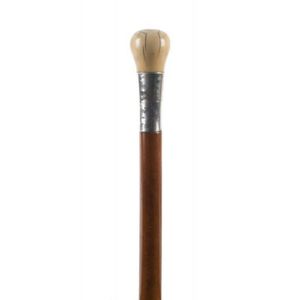
19th Century Ivory and Silver Walking Stick
A walking stick, large ivory handle with silver collar and cane shaft, 19th century, 86 cm long
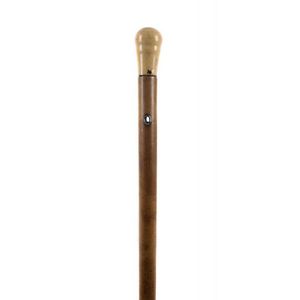
19th Century Ivory Handled Walking Stick
A walking stick, ivory handle with cane shaft, 19th century, 86 cm long

Ivory-topped 19th Century Walking Stick
A walking stick with ivory top and cane shaft, 19th century, 83 cm long

19th Century Indian Elephant-Handle Ebony Walking Stick
A walking stick, elephant handle, ebony with ivory inlay, Indian, 19th century, 92 cm long
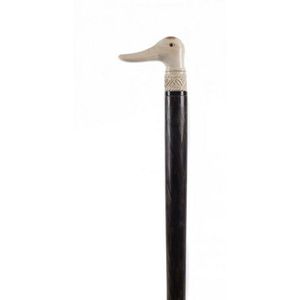
Ivory Duck Head Walking Stick
A walking stick, carved ivory duck's head handle with palmwood shaft, early 20th century, 91 cm long

Silver and Ivory Inlaid Walking Stick, 19th Century
A fine walking stick inlaid with silver and ivory, 19th century, 89 cm long

19th Century Sterling Silver and Ivory Walking Cane
A walking cane, sterling silver and ivory, 19th century, 94 cm long
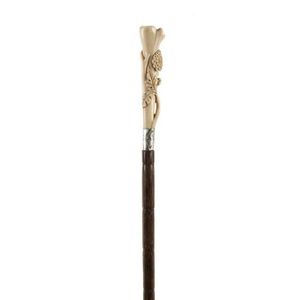
Ivory and Malacca Walking Cane - 19th Century
A walking cane, carved ivory with Malacca shaft, 19th century, 89 cm long
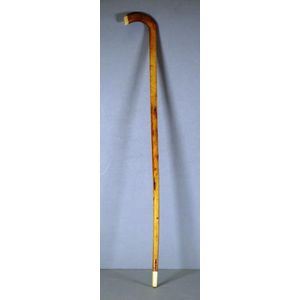
Ivory-Capped Vintage Bone Walking Cane, 82cm Length
Vintage bone walking cane with ivory capped handle and ferule., length 82 cm.

Whalebone Swagger Stick with Ivory Finial
A whalebone swagger stick, with carved and wrythen turned shaft fitted with an ivory small ball finial affixed to the shaft with a rosewood and horn collar. Length 50 cm.

Whalebone Walking Stick with Ivory Handle
A 19th century whalebone walking stick, the handle formed of an octagonal tooth ivory knob tapering to join the shaft with a band of rosewood and further tooth ivory, the tapering cylindrical shaft of good quality bone. Length 89 cm.

Dragon Head Ivory Cane with Ebony Shaft
A walking cane with stylised S.E. Asian dragon head finial, carved in ivory (very slight losses) fixed with a horn collar to a slender tapering ebony shaft. Length 91 cm

Marine Ivory Walking Stick with Whale's Tooth
A marine ivory handled walking stick, the small natural whale's tooth joined by a collar of alternating narrow bands of baleen and marine ivory to a tapering jarrah shaft. Length 89 cm
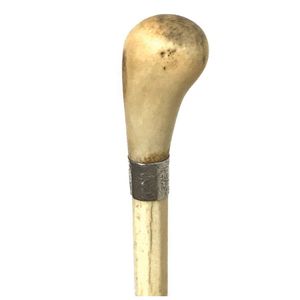
Whalebone Walking Stick with Ivory Handle
A 19th century whalebone walking stick, the handle formed of a tooth ivory asymmetrical knob tapering to join to the octagonal tapering whalebone shaft at an engraved silver plated band. Length 89 cm

Whalebone Walking Stick with Ivory Handle
A 19th century whalebone walking stick, the handle formed of a tooth ivory knob tapering to join to the whalebone shaft at a silver plated band. Length 83.5 cm
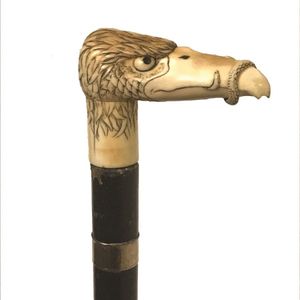
Marine Ivory Eagle Head Walking Stick with Snake
A carved marine ivory eagle head walking stick, finely carved with a small snake held in its beak (slight loss at tip), fitted to an ebonised stick with two gold plated collars. Length 86.5 cm

19th Century Ivory Greyhound Handled Walking Stick with Gold Mount
A quality 19th century carved ivory greyhound handled walking stick, glass set eyes, fine detail, the substantial later 9ct. rose gold mount with elaborate scroll engraving (17.7gm.), fitted to an old malacca cane shaft.

Ivory Egyptian Revival Walking Cane, 1810
An Egyptian revival carved ivory walking cane English, circa 1810

Marine Ivory & Whalebone Turk's Knot Walking Stick
A quality 19th century marine ivory and whalebone carved Turk's Knot walking stick, the marine ivory handle carved as a double strand Turk's Knot with three baleen discs connecting the finely carved shaft with notch, ribbed and spiral sections banded with…

Mahogany and Ivory Walking Stick with SS Wairarapa Engraving
A mahogany and ivory walking stick, the mahogany shaft terminating with a silver collar engraved S.S. Wairarapa (referencing the sinking on the reef at Great Barrier Island in 1894 with the loss of 140 lives) and a Japanese ivory handle carved with lions.…

Ivory-handled Malacca Cane Walking Stick
An ivory handled Malacca cane walking stick, the cane shaft terminating in a turned ivory handle with a carved garter collar, the shaft with large ivory ferrule. Length 87 cm. Provenance: The Flower Family Collection.

Whalebone and Ivory Walking Cane
A whalebone and ivory walking cane, the shaft of alternating plain and patterned bone sections, terminating in a wide silver collar and spherical ivory handle. Length 88 cm. Provenance: The Flower Family Collection.

Whalebone and Ivory Walking Stick
An impressive whalebone and marine ivory walking stick, the main portion of shaft in whalebone with five smaller sections of marine ivory and ivorine carved in varied patterns with baleen embellishments, the shaft terminating in clenched fist carved from…

Whalebone Walking Stick with Marine Ivory Handle
A whalebone walking stick, the shaft with metal ferrule the marine ivory handle in the form of a Turk's knot. Provenance: The Flower Family Collection. Length 88.5 cm

Marine Ivory Dog Head Cane
A short whalebone cane, the shaft with metal ferrule, the marine ivory handle in the form of a dog's head, glass eyes and engraved silver collar. Provenance: The Flower Family Collection. Length 66 cm

Whalebone cane with marine ivory and horn discs
A whalebone cane, the shaft with metal ferrule the top with four marine ivory discs and five horn discs, a small silver plate cartouche with dog to the front, handle absent. Provenance: The Flower Family Collection. Length 83 cm

Antique Ivory Oriental Walking Cane Handle
Antique oriental turned ivory walking cane handle, with brass screw fitting attachment. Height 7 cm (handle only).

Ivory Pipe Walking Stick with Mop Beetles Decoration
Shibiyama and ivory pipe walking stick with ivory topped handle decorated with Mop beetles that unscrews to reveal pipe stem that fits to handle to form pipe, on a rosewood stick section, length 87 cm

Ivory Lion Head Walking Stick with Brass Inscription
Ivory lion head walking stick on rosewood stem still with presence of 'Knots' that taper down to rubber foot, the ivory head well carved sitting up brass band that is inscribed A.Ferguson, length-88 cm

Elegant Ebonised Walking Cane with Ivory and Horn Accents
A vintage walking cane, ebonised finish, ivory collar with horn top.

Malacca Cane Walking Stick with Ivory Handle
A malacca cane and ivory handled walking stick, age crack to the handle, bone ferrule.

Edwardian Ivory and Ebony Walking Stick
An Edwardian ivory handled and ebony walking stick, the mildly curved handle of good size, the engraved silver collar hallmarked Chester 1903. Length 91 cm

Ivory-handled Satinwood Walking Stick
A 19th century walking stick, the satinwood shaft with ivory handle, ivory ferrules and ivory tip. Length 92 cm

Ebonised Rosewood Walking Stick with Ivory Finial
A 19th century ebonised rosewood walking stick, the wooden shaft with marine ivory ball finial with turned ribbed detailing. Length 85 cm

Ivory Lion Head Walking Stick with Silver Collar
Antique Ivory lions head & Malacca walking stick, with sterling silver collar, length 87 cm .

M.Noble Ivory Cane Handle with Kangaroo and Lion Carvings
Gentleman's walking cane handle, carved ivory with kangaroo holding bat & lion holding ball, marked M.Noble, from M.F./ Manchester 1899'.
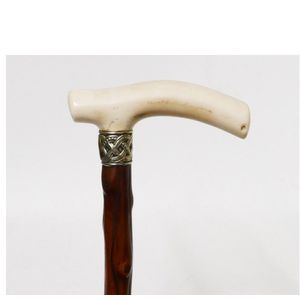
Hazelnut Cane with Ivory Handle and Silver Collar
A 19th century hazelnut walking cane, the shaft terminating in an ivory handle with a decorative silver plate collar.

Marine Ivory Fist Walking Stick Handle
A 19th century marine ivory carved walking stick handle modelled as a clenched fist, the wrist narrowing, no shaft attached. Height 7 cm
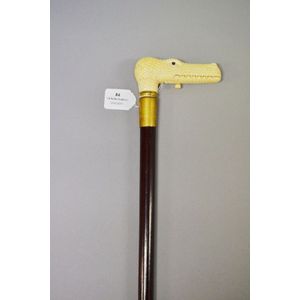
Crocodile Handle Walking Stick with Bone/Marine Ivory
Walking stick with bone / marine ivory crocodile handle, approx 90 cmlong

Marine Ivory Dog Handle Walking Stick, 92cm Long
Walking stick with bone / marine ivory dog handle, approx 92 cmlong

Whale Ivory Walking Stick with Baleen Rings & Facetted Handle
Whale ivory & whalebone walking stick with baleen rings & facetted handle

Fiddleback Blackwood Walking Stick with Ivory Bonzo Dog
A fiddleback blackwood walking stick with carved ivory Bonzo dog, circa 1925, 88 cm
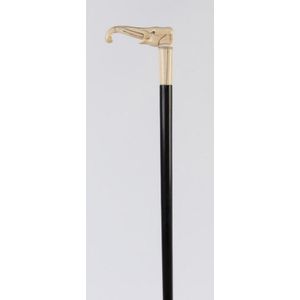
Ebony Walking Stick with Ivory Elephant Handle (8 words)
An ebony walking stick with carved elephant's head ivory handle, early 19th century, 86 cm

Ebonised Malacca Walking Stick with Albatross Head
An unusual ebonised malacca walking stick with albatross head in horn and ivory with cut metal eyes, early 19th century, 86 cm

Georgian Ivory Greyhound Walking Cane, 19th Century
A fine Georgian walking cane with carved ivory greyhound handle and gilt metal collar, 19th century, 85 cm

Anglo-Indian Inlaid Walking Stick, 19th Century
An Anglo-Indian carved bone and ivory inlaid walking stick, 19th century, 95 cm

Ivory and Tortoiseshell Walking Cane, 19th Century
A walking cane with ivory handle inlaid with tortoiseshell, 19th century, 82 cm

Spiral Carved Bone and Ivory Walking Stick
Antique bone and ivory walking stick, late 19th century, the bone or panbone shaft spiral carved to the lower section, diamond patterns to the mid section, the upper section faceted and inlaid with mother-of-pearl and tortoiseshell, with an ivory…

Melbourne Rifle Club's 1900 Walking Stick with Ivory Handle
An Australian Walking stick with an ivory handle, and a gold band inscribed, Presented from the Melbourne rifle club 1900

Victorian serpent walking stick with ivory nib
Victorian ivory carved tortoiseshell serpent handled walking stick with an ivory nib & a silvered collar. Length 86.5 cm

Victorian Ivory Serpent Walking Stick
Victorian ivory carved tortoiseshell serpent handled walking stick with an ivory nib & a silvered collar. Condition good, minor age related wear. Length 86.5 cm

1893 London Hallmarked Silver and Ivory Walking Cane
Sterling silver and ivory handled walking cane, hallmarked London 1893, 91 cm long.

Victorian Marine Ivory Crouching Hound Stick Handle
A Victorian marine ivory stick handle, in the form of a crouching hound, minor damage. Length 9 cm

Qing Dynasty Ivory and Feather Fan
An antique Cantonese ivory and feather fan, Qing Dynasty, 19th century; feathers later, finely carved and comprising myriad figures, pavilions within traditional gardens embellished with auspicious fruits and foliage, each stick individually relief carved…

Antique Ivory Dog Head Walking Stick Handle
Antique ivory dogs head walking stick handle, with glass eyes, length 13.5 cm approx (as inspected)

19th Century Ivory 'Three Friends' Wrist Rest
An ivory 'three friends' wrist rest, 19th century, naturalistically carved in the form of a hollowed section of a pine trunk, the gnarled convex surface with a branch of pine needles, flowering prunus and bamboo canes in high relief extending over the…
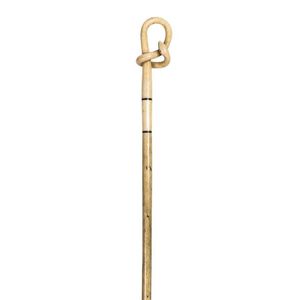
Whalebone Walking Stick with Ivory Snake Handle
A whalebone inset walking stick with walrus ivory snake handle, 19th century, 90 cm long

Victorian Silver and Ivory Walking Stick with Provenance
A late Victorian silver, ivory and malacca cane walking stick, the approximate T-form ivory handle with decorative embossed silver cap ends and fitting to the tapered malacca shaft, engraved 'W.S.' reputedly a presentation upon the achievement of becoming…

Ivory Monkey Carved Walking Cane with Gold Collar (Repair)
Ivory handled walking cane the handle carved with monkey, gold collar (repair)
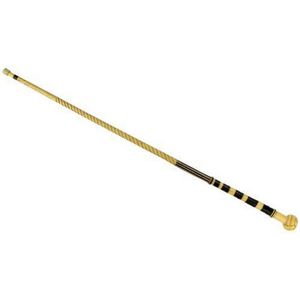
Ivory, Whalebone, and Tortoiseshell Walking Stick with Inlay
Ivory, whale bone & tortoiseshell walking stick having an ivory twist handle, with a whalebone cane with tortoiseshell inlay throughout. Condition, good to fair, some loose inlay, length, 84 cm

Antique Ivory Cane with Engraved Silver Cap
Old Ivory cane with brass ferule and silver cap with early hand engraved initials. The cap has possibly been lacquered and there is some minor repairs to cane, approx 90 cm long

Monkey Ivory and Bamboo Walking Sticks
Two walking sticks, one with an ivory handle with carved monkey (90 cm), one with 2 mm bamboo divisions and a curved handle (90 cm).

Ivory-handled walking sticks
Two walking sticks, one with a straight ivory handle (90 cm), one with an ivory band and a curved ivory handle (87 cm).

Ivory Inlaid Floral Walking Stick with Compartment
An early 19th century ivory mounted hardwood walking stick, the ivory mount inlaid in studded metal with a floral pattern, the top with a pierced removable cover opening to a small compartment, 91 cm long

19th Century Ivory Cane with Foliate Engraved Mount
A 19th century ivory cane, with a faceted foliate engraved binchbeck mount to the top, above two holes for a cord strap, metal mount to the tip, (natural age hairlines to the ivory, wear and dents to the pinchbeck mount), 94 cm wide

Snake-carved Hardwood Walking Stick with Ivory Inlay
A Primitive hardwood walking stick, 19th/20th century, the shaft carved with an entwined snake with ivory inlaid eyes, rising to a clenched fist, 87 cm long

Floral Carved Ivory Walking Stick Handle
Antique carved ivory walking stick handle floral decoration, 13.5 cm long approx.
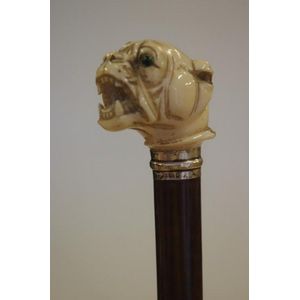
Sterling Silver Collared Snakewood Walking Cane, 1924 London Hallmark
Snakewood & carved ivory walking cane with sterling silver collar hallmarked London 1924, 90.5 cm long

Dragon Ivory Parasol Handle
Fine carved ivory parasol handle dragon head handle with coiled body amongst cloud to shaft

Marine Ivory Fist & Viper Walking Cane
Marine ivory carved rosewood walking cane depicting a clenched fist holding a viper with a rope twist cuff. Condition good, age related wear. Length 92 cm

Ivory Masked Cane and Parasol Handle
Ivory walking cane handle with mask head and an ivory parasol or umbrella handle

19th Century Anglo-Indian Malacca & Ivory Walking Cane
A carved malacca & ivory topped walking cane, Anglo-Indian, 19th century. 88 cm long.

Antique Narwhal Tusk & Silver Walking Cane
An antique Narwhal tusk and silver walking cane, later 19th century, the cane of traditional tapering form and brass capped to the base, a turban style handle in possibly walrus ivory, the sterling silver collar with inscription dated 1883. Length 85 cm

Anglo-Indian Ivory Walking Stick from Melba Collection
An Anglo-Indian ivory walking stick, late 19th century the six section stick of naturalistic branch form 87 cm long. Property from the Collection of Dame Nellie Melba GBE

Ivory and Glass Walking Stick - 120cm
Walking stick with ivory top & a cut glass insert. Condition good to fair, some cracking to the ivory. Length 120 cm

Walrus Ivory and Ebony Walking Sticks, 19th/20th Century
Two walrus ivory and ebony walking sticks, late 19th/20th century, the longest 92 cm

Double-Sided Ivory Walking Stick Top with Medieval Portraits
A rare double-sided portrait, carved ivory walking stick top, late 19th century. Depicting 'Young and Old' medieval style figurative gentleman portraits. Height 19.5 cm

Ivory Bulldog Head Antique Walking Cane (8 words)
Antique walking cane with caved ivory bulldog head to top. Fine quality, C:1870

Antique Mallaca Walking Stick with Ivory Frog Handle
Rare antique mallaca walking stick, with carved ivory Art Deco frog handle, C:1820
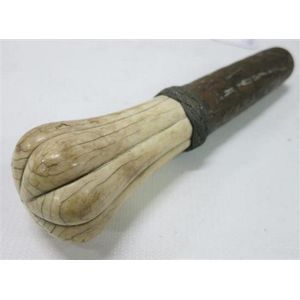











 Loading more...
Loading more...